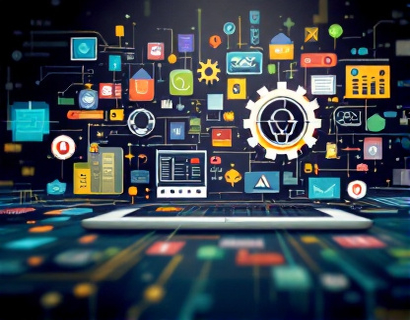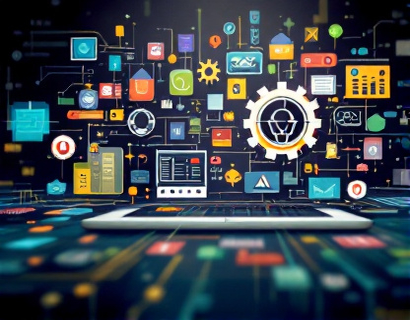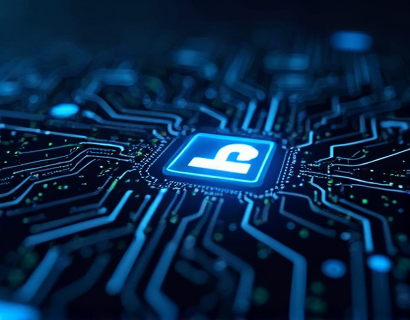Seamless AI and Blockchain Integration: An Essential Guide for Business Digital Transformation
The integration of Artificial Intelligence (AI) and blockchain technology represents a pivotal shift in the landscape of business operations. As companies strive to stay competitive in an increasingly digital world, understanding how to seamlessly integrate these technologies is crucial for successful digital transformation. This guide serves as an essential resource for business leaders aiming to harness the power of AI and blockchain to streamline operations, enhance security, and unlock new growth opportunities.
AI and blockchain, though distinct in their functionalities, complement each other in ways that can revolutionize business processes. AI, with its ability to analyze vast amounts of data and make intelligent decisions, paired with blockchain's inherent security and transparency, creates a powerful synergy. This integration can lead to more efficient, secure, and innovative business models. However, the journey to seamless integration is complex and requires a strategic approach.
Understanding AI and Blockchain
To effectively integrate AI and blockchain, it's essential to first understand the fundamentals of each technology.
AI refers to the simulation of human intelligence in machines that are programmed to think and learn like humans. These systems can process information, recognize patterns, and make decisions with minimal human intervention. AI encompasses various subfields, including machine learning, natural language processing, and computer vision.
Blockchain, on the other hand, is a decentralized digital ledger technology that records transactions across multiple computers in such a way that the registered transactions cannot be altered retroactively. This technology ensures transparency, security, and immutability, making it ideal for applications requiring trust and traceability.
The combination of AI and blockchain can address some of the limitations of using these technologies in isolation. For instance, AI can enhance the efficiency of blockchain networks by optimizing consensus mechanisms and improving data processing, while blockchain can provide a secure and transparent environment for AI models to operate.
Benefits of AI and Blockchain Integration
The integration of AI and blockchain offers numerous benefits that can drive business transformation:
- Enhanced Security: Blockchain's cryptographic techniques and decentralized nature make it highly secure. When combined with AI, which can detect and respond to security threats in real-time, the overall security of business operations is significantly bolstered.
- Improved Efficiency:
- Data Integrity and Trust:
- Innovative Business Models:
AI can automate and optimize various processes within a blockchain network, reducing manual interventions and increasing operational efficiency. For example, smart contracts can be enhanced with AI to execute more complex and dynamic business logic.
Blockchain ensures that data is tamper-proof and transparent, which is crucial for AI systems that rely on high-quality data for accurate predictions and decisions. This synergy enhances the reliability of AI-driven insights.
The combination of AI and blockchain enables the creation of new business models, such as decentralized finance (DeFi) and tokenized assets, which can open up new revenue streams and market opportunities.
Challenges in AI and Blockchain Integration
Despite the potential benefits, integrating AI and blockchain comes with its own set of challenges:
- Technical Complexity:
- Scalability Issues:
- Regulatory Uncertainty:
- Data Privacy Concerns:
Both AI and blockchain are complex technologies that require specialized knowledge to implement effectively. Businesses need to invest in skilled personnel or partner with experts to navigate the technical intricacies.
Blockchain networks, especially public ones, can face scalability challenges. Integrating AI to optimize these networks is essential but requires careful planning and advanced solutions.
The regulatory landscape for both AI and blockchain is still evolving. Businesses must stay informed about legal requirements and ensure compliance to avoid potential penalties.
While blockchain provides transparency, it can also raise privacy issues. Integrating AI to manage and anonymize data is crucial to address these concerns and maintain user trust.
Strategies for Seamless Integration
To overcome the challenges and leverage the benefits of AI and blockchain integration, businesses can adopt the following strategies:
1. Define Clear Objectives
Before embarking on the integration journey, businesses should clearly define their goals. Whether it's improving supply chain transparency, enhancing customer experiences, or developing new financial products, having a clear objective will guide the integration process.
2. Build a Skilled Team
Assemble a team with a diverse skill set, including AI experts, blockchain developers, and industry specialists. Continuous learning and upskilling are essential to keep pace with the rapidly evolving technologies.
3. Start with Pilot Projects
Begin with small-scale pilot projects to test the integration of AI and blockchain in a controlled environment. This approach helps identify potential issues and refine processes before a full-scale implementation.
4. Leverage Hybrid Blockchain Models
Consider using hybrid blockchain models that combine public and private blockchains to balance transparency and privacy. AI can play a crucial role in managing access controls and ensuring data integrity across different blockchain segments.
5. Optimize Consensus Mechanisms
Implement AI-driven solutions to optimize blockchain consensus mechanisms, reducing energy consumption and increasing transaction speeds. For example, AI can predict network conditions and adjust consensus parameters accordingly.
6. Ensure Data Quality and Management
High-quality data is essential for AI models to function effectively. Use AI to clean, validate, and manage data within the blockchain ecosystem, ensuring that the data fed into AI systems is accurate and reliable.
7. Focus on User Experience
Design user-friendly interfaces and processes that make the integration of AI and blockchain accessible to all stakeholders. This includes developing intuitive applications and providing comprehensive training and support.
8. Stay Compliant and Ethical
Adhere to regulatory requirements and ethical standards when integrating AI and blockchain. Implement AI governance frameworks to ensure responsible use of these technologies and maintain stakeholder trust.
Case Studies and Real-World Applications
Several industries have successfully integrated AI and blockchain to drive innovation and efficiency:
Supply Chain Management
A leading retailer implemented a blockchain-based system to track product origins and movements, integrating AI to predict demand and optimize inventory levels. This integration reduced fraud, improved transparency, and enhanced customer satisfaction.
Financial Services
A major bank used AI to automate KYC (Know Your Customer) processes on a blockchain platform, streamlining compliance and reducing operational costs. The AI system ensured that only verified and accurate data was recorded on the blockchain.
Healthcare
A healthcare provider integrated AI with a blockchain network to manage patient data securely and efficiently. AI algorithms analyzed patient data to provide personalized treatment recommendations, while blockchain ensured data integrity and patient consent management.
Future Trends and Innovations
The integration of AI and blockchain is an evolving field with exciting future trends:
- Increased Adoption of Decentralized AI:
- AI-Powered Blockchain Governance:
- Integration with IoT:
Decentralized AI models, where AI training and inference are distributed across a blockchain network, can enhance privacy and reduce reliance on centralized data repositories.
AI can optimize blockchain governance by predicting network behavior, detecting anomalies, and suggesting improvements to consensus mechanisms.
The combination of AI, blockchain, and the Internet of Things (IoT) can create smart and autonomous systems, enabling real-time data processing and decision-making.
As these technologies continue to mature, businesses that proactively integrate AI and blockchain will be better positioned to capitalize on emerging opportunities and stay ahead of the competition.
Conclusion
Integrating AI and blockchain is a transformative journey that requires careful planning, strategic execution, and a commitment to innovation. By understanding the benefits, addressing the challenges, and adopting best practices, businesses can unlock new growth opportunities and drive digital transformation. The future of business lies in the seamless integration of these powerful technologies, paving the way for a more secure, efficient, and innovative world.










































